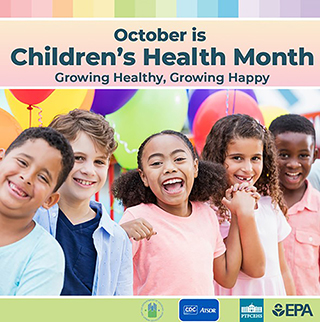Task Force Publishes 2024-2028 Priority Areas
February 2024
The President’s Task Force on Environmental Health Risks and Safety Risks to Children have set priorities for 2024-2028.
This comprehensive roadmap outlines initiatives across key areas:
- Lead Exposures
- Children in Emergencies and Disasters
- Chemical Exposures
With short- and long-term actions addressing data gaps; regulations and policies; communication and engagement; and interagency coordination this document showcases the Task Force’s plan for safeguarding childrens health amidst the latest challenges.
Task Force Reports Progress on the Federal Lead Action Plan
April 2024
Although the number of children in the U.S. exposed to lead has dropped significantly in the past decade, thousands of children are still exposed. Lead exposure is not equal among all children–national data suggest minority children, children living in families below the poverty level, and children living in older housing have significantly higher risk for elevated blood lead levels. No safe blood lead level in children has been identified.
The President’s Task Force on Environmental Health Risks and Safety Risks to Children has published its Progress Report on the Federal Lead Action Plan to Reduce Childhood Lead Exposures and Associated Health Impacts. The report provides a comprehensive update on efforts taken by the federal government and advancements made between December 2018 and April 2024 in reducing childhood lead exposures and associated health effects.
Children's Health Month
October 2024

October is Children’s Health Month. Throughout October, the Task Force will be working to raise awareness of the unique health risks faced by children from environmental factors. Federal agencies are emphasizing the importance of protecting children now so that they can grow up healthy and happy. Persons can find more information online, along with a Children’s Health Outreach Toolkit that can be used and modified by organizations to implement their own awareness activities or amplify those of the federal agencies.
The theme for Children’s Health Month is Growing Healthy, Growing Happy. Each week in October is focused on different sub-theme:
October 1-5 – Strong Bodies and Minds
- Children's growing bodies are more vulnerable than adults to environmental health threats. Protecting their health now is key to strong futures.
October 6-12 – Healthy Spaces
- Ensure homes, schools, childcare facilities, playgrounds and other spaces where children spend most of their time are built and improved with their health in mind.
October 13-19 – Empowered Communities
- Equip communities with the knowledge and resources necessary to guarantee every child is protected from health risks.
October 20-26 – Bright Futures Begin Lead Free
- National Lead Poisoning Prevention Week – Get the facts. Get your child tested. Get your home tested.
October 27-31 – Planning Ahead
- Keep children healthy in the face of a extreme weather events, natural disasters, and other emergency situations by preparing now for future challenges.
Sign up for the President’s Task Force email list to get access to more children’s environmental health and children’s safety information and resources.
UNICEF to Share Video on President’s Task Force
November 2024
In 2023, UNICEF, part of the United Nations, established the Children’s Environmental Health Collaborative to galvanize international action to address children’s environmental health issues. The Collaborative engaged partners to amplify UNICEF’s work to protect children’s environmental health. As part of Children’s Health Month in October, the co-chairs of the Steering Committee of the President’s Task Force on Environmental Health Risks and Safety Risks to Children (Task Force) recorded a video for the Children’s Health Collaborative. In the video, Grace Robiou, director of the EPA Office of Children’s Health Protection and Leith States, chief medical officer in HHS’s Office of the Assistant Secretary of Health, describe the goals and work of the Task Force. UNICEF plans to disseminate the video to policymakers, public health officials, and others in developing countries as a model for how to coordinate cross-governmental efforts to address children’s environmental health issues.

